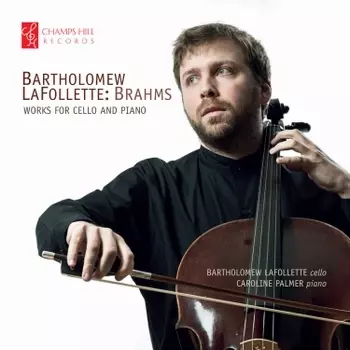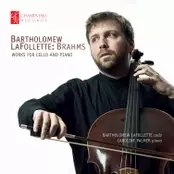Bartholomew Lafollette: Brahms - Works For Cello And Piano - Electronic
CHRCD134-E
- About
Artist(s):
British/American cellist Bartholomew LaFollette makes his debut recording on Champs Hill Records with a programme of Brahms, bookended by the two great sonatas for cello, the second of which (F major Op 99) is heard in the brand new edition by Bärenreiter.
"To say that I’ve always had a great love for these sublime works is an understatement. I grew up knowing the sonatas by Brahms as so many cellists do – the E minor, in particular, being a piece I’ve played since I was 12 (although I’m sure not very well back then) so to me, playing these works feels like coming home."
The programme also includes transcriptions of Brahms’ Four Serious Songs (arr Shafran) which LaFollette describes as growing to love ‘by osmosis’ through hearing them at home, performed by his parents (his father a classically trained amateur musician, doctor and computer scientist and his mother a professional pianist). He describes this project as inspired by "Home and family. Two very important facets of both my existence as a human being and as an artist."
LaFollette has a rich and varied career as an international soloist and chamber musician. After being launched by YCAT (Young Classical Artists Trust) he went on to win first prize at The Arts Club’s and Decca Records’ inaugural Classical Music Award. He was also the first recipient of the Irish Chamber Orchestra’s Ardán Award. Hailed by the Irish Times for being “as free in touching the heartstrings as he was in dashing off dazzling runs”, Bartholomew’s highlights with orchestra include performances of Dvořák’s Cello Concerto with the Royal Philharmonic Orchestra, Walton and Elgar Cello concertos in the Barbican Hall as well as appearing as soloist with the City of London Sinfonia.
In 2011 at the age of twenty-six, Bartholomew LaFollette was appointed Principal Cello Teacher at the distinguished Yehudi Menuhin School. Bartholomew plays on an especially fine example of a Giovanni Dollenz cello from 1841 and a bow by François Xavier Tourte from 1790.
- Sleeve Notes
As a young boy, Brahms was given rudimentary lessons on both the violin and cello by his father, although it was the piano that primarily activated his executant and creative imagination. Accordingly, his first published works included three virtuoso piano sonatas that rejoice in the instrument’s potential for rich and powerful middle-register (cello) sonorities.
Brahms’s understanding of string instruments and their expressive potential was considerably enhanced by early contact with two of the most renowned violinists of the age. He spent much of his early teens trying to help support his poor family by playing the piano in back-street taverns (thinly-disguised brothels), the anguished memory of which was to haunt him for the rest of his life. He was finally released from this sordid existence when in 1850 the celebrated gypsy violinist, Eduard Reményi, asked him to become his official accompanist, and such was Brahms's immense skill that at one concert he compensated for an out-of-tune piano by transposing all of the accompaniments at sight. The impact of playing popular East European folk music with Reményi is felt particularly in his 21 Hungarian Dances as exemplified by the moody swagger and irresistible chutzpah of No.20, heard here in an expert arrangement by celebrated Italian virtuoso and teacher, Carlo Alfredo Piatti (1822–1901).
Two years later, Brahms was introduced to the great German violin virtuoso, Joseph Joachim, for whom he would later compose his Violin Concerto, three violin sonatas and Double Concerto for violin and cello. Joachim was overwhelmed by Brahms's ‘undreamt of originality and power’ and immediately arranged a visit to Weimar to meet Franz Liszt and then in September 1853 Robert Schumann, who enthusiastically hailed him as the ‘natural heir and successor to Beethoven’.
It was inevitable that sooner or later Brahms would beat a path to Vienna, the musical capital of Europe, although his first visit during the winter of 1862–63 was only intended originally as a short stay. However, when a vacant conducting post with the Philharmonic back in Hamburg went unexpectedly to someone else, he was forced to rethink his options and auditioned successfully for the directorship of the famous Vienna Singakademie.
By now, Brahms was already working on his first accompanied sonata, not for the violin as might have been expected, but for the cello. The inspiration to finish the sonata came from one of the Singakademie’s most distinguished members, Lieder composer and vocal expert, Josef Gänsbacher (1829–1911), who it turned out was also an enthusiastic amateur cellist. Brahms designed an unusually sonorous piano part focussed on the tenor and baritone registers, so much so that during an early play-through with Gänsbacher, the cellist complained that he was struggling to make himself heard, to which the quick-witted composer responded with a twinkle in his eye: ‘It’s probably just as well!’
Brahms got as far as completing the first three movements of the intended four-movement structure – an Allegro non troppo of profound emotional and structural density, followed by a noble Adagio affetuoso and an Allegretto quasi Menuetto that tantalisingly fuses stylistic retrospection with a beguiling Romantic impulse. Yet such was the expressive richness of the music he had so far produced he struggled to come up with a finale that would provide a convincing foil. Three years later he returned to the work and putting the slow movement to one side (it would re-emerge 20 years later in the F major Sonata), moved the minuetto into central position and added a powerful, fugal finale of inexorable forward momentum.
If the yearning, deeply felt phrases of the E minor Sonata’s opening allegro show an obvious kinship with the lyrical intensity of the near-contemporaneous string sextets and first two piano quartets, the F major of 1886 lies closer to the motific concision and compression familiar from the Fourth Symphony (completed the previous year) and Double Concerto of 1887. The concerto’s solo cello part and that of the new sonata were written specifically for Robert Hausmann (1852–1909), Piatti’s most famous pupil and cellist in the Joachim Quartet, who five years previously had premiered Max Bruch’s Kol Nidrei and whose dazzling playing of Dvorak’s Cello Concerto caused Brahms to exclaim that if he had known such a thing were possible he would have written one himself.
It was Hausmann’s massive tonal projection that inspired Brahms to employ an imposing range of full-blooded piano textures that would overwhelm many a lesser cellist. Elizabeth von Herzogenberg, one of Brahms’s closest friends and a regular correspondent for over 20 years, was ecstatic when she first set eyes on the score, enthusing perceptively in a letter from Berlin dated 2 December 1886: ‘So far I have been most thrilled by the first movement. It is so masterly in its compression, so torrent-like in its progress, so terse in the development... I can’t tell how much I enjoyed the soft, melodious Adagio… and I should love to hear you [i.e. Brahms] play the vigorous scherzo third movement...It must be agitated without being hurried, legato despite its unrest and impetus.’ This recording takes account of the latest research in Bärenreiter’s recently published urtext edition.
Only three years after composing the F major Sonata, the 56-year-old Brahms announced the first of several semi-retirements, although it wasn’t long before his creative pen was active again, composing some of his most introspective and nostalgic masterpieces, including the Clarinet Quintet, Trio and sonatas, and a series of solo piano miniatures of exquisite poignancy. During 1896, he began suffering symptoms of the liver cancer (diagnosed initially as jaundice) that would claim his life early the following year.
During May, the month in which his beloved Clara Schumann (widow of the composer Robert) died and he turned 63, Brahms’s thoughts understandably turned towards death and the transience of life. In the first three of his Vier Ernste Gesänge (‘Four Serious Songs’), originally written for baritone and piano and therefore particularly appropriate for cello’s dark introspection, he faced his own mortality as never before in three passages from Ecclesiastes/Ecclesiasticus in the Old Testament.
Brahms was by no means a conventional believer in God, which explains his carefully chosen texts’ occasional ambiguities. In the first (‘One thing befalleth the beast and the sons of men’) death comes to us all whether we be human or animal, while the second (’So I returned and considered’) reflects on whether the unborn are the luckiest of all as they have not born witness (unlike the dead and living) to the sins of the world. ‘O death, how bitter you are’ reflects that the advance and decrepitude of old age is unavoidable no matter how much wealth one has accumulated, although at least the final song from 1 Corinthians (‘Though I speak with the tongues of men and angels’) ends on a more positive note with the famous lines that of the eternal virtues of faith, hope and charity ‘the greatest of these is charity.’
© Julian Haylock
- Press Reviews
- Delivery & Returns
If you order an electronic download, your download will appear within your ‘My Account’ area when you log in to the Champs Hill Records website.
If you order a physical CD, this will be dispatched to you within 2-5 days by Royal Mail First Class delivery, free worldwide.
(We are happy to accept returns of physical CDs, if the product is returned as delivered within 14 days).
If you have any questions about delivery or would like to notify us of a return, please get in touch with us here.

